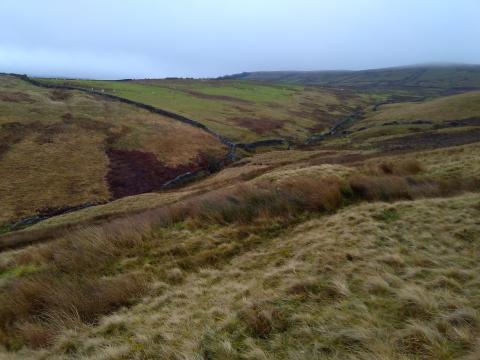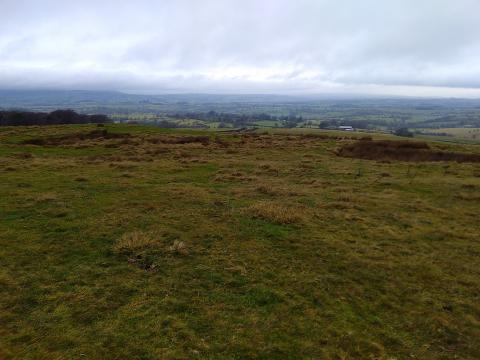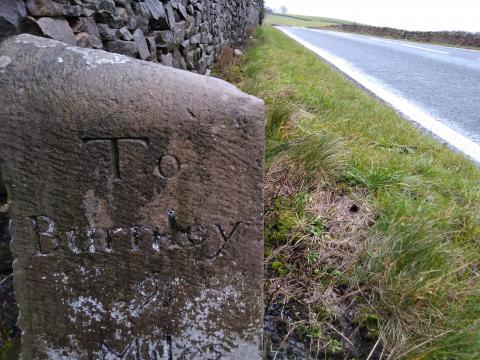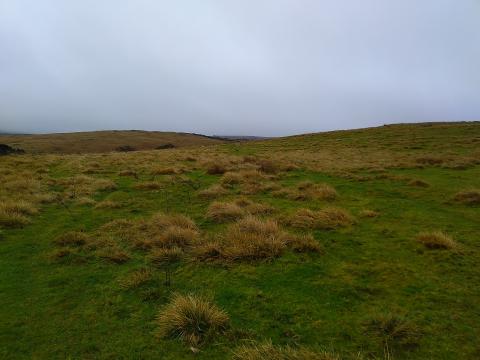Bale Hill, Rimington Moor & Tory Log Clough

I spent some time away this week. My own house is full of distractions and demands to be cleaned, so I booked into some beautiful, local accommodation armed with several books including the Diaries of Rev Oliver Heywood 1630-1702 and some walking gear. Between the worst rains I walked along Wytha Road past Middop Hall, and then up onto Rimington Moor, which is as bleak as it sounds. Had I kept going, I might have come out at Roughlee or Barrowford, but the wind was cold and the rains were wetting my legs. I crossed Tory Log Clough, above, a steep ravine in which a busy stream gurgles. The University of Nottingham’s Survey of English Place-Names offers no explanation for this, merely noting its origin is Terriloghole, first recorded in 1755, so anyone seeking a political quip is likely to be disappointed. I also climbed Bale Hill, below, which afforded views of Middop and the Ribble Valley. I whimsically speculated that Bale was a corruption of Baal, the eastern fertility god whose cult would prove most popular in modern Britain. Again, the Uni of Nott’s Survey suggests it comes from the Old English bæð 'bath' and lēah 'woodland clearing'. Nothing to see here, keep moving, keep moving. I kept going till I came to Craven Lathe Farm, walked a while along the A682 before passing Newfield Edge Hall where my Robinson ancestors farmed at the time of Oliver Cromwell. I returned to my luxury accommodation where I dried out and allowed Reverend Heywood’s recollections and anecdotes to edify my spirit.

For that brief half mile that I traversed the busy A682, silently thanking God that the verges were wide enough to serve as a pavement, I came across an old milestone by Crag Farm. According to Historic England, it is early nineteenth-century, and states on the one side
To Gisburn 3 Miles
and on the other
To Burnley 9 Miles

We have worshippers pass that stone each week coming from the direction of Burnley, but I daresay that they, like me, have never stopped to read it. It was erected in the days when people walked or went by cart and horse, and had the time and inclination to inspect milestones to see how much further till their destination. In one sense, New Year’s Day was a milestone through which we have passed, but what is our destination? For the believer, it is death and therefore heaven with Christ:
So we are always confident, knowing that while we are at home in the body we are absent from the Lord. For we walk by faith, not by sight. 8 We are confident, yes, well pleased rather to be absent from the body and to be present with the Lord. 2 Cor 5:6-7
The further I travel from my birth, the nearer I get to my death. For the Christian, this is a wonderful prospect, the happiest outcome imaginable. For the unbeliever, death without Christ is a terrible, looming prospect, bleaker than a sodden Rimington Moor on a wintry, January afternoon:
But Abraham said, ‘Son, remember that in your lifetime you received your good things, and likewise Lazarus evil things; but now he is comforted and you are tormented. And besides all this, between us and you there is a great gulf fixed, so that those who want to pass from here to you cannot, nor can those from there pass to us.’ Luke 16:25-26

- Log in to post comments


 Sunday Worship 10.45am & 6.00pm
Sunday Worship 10.45am & 6.00pm